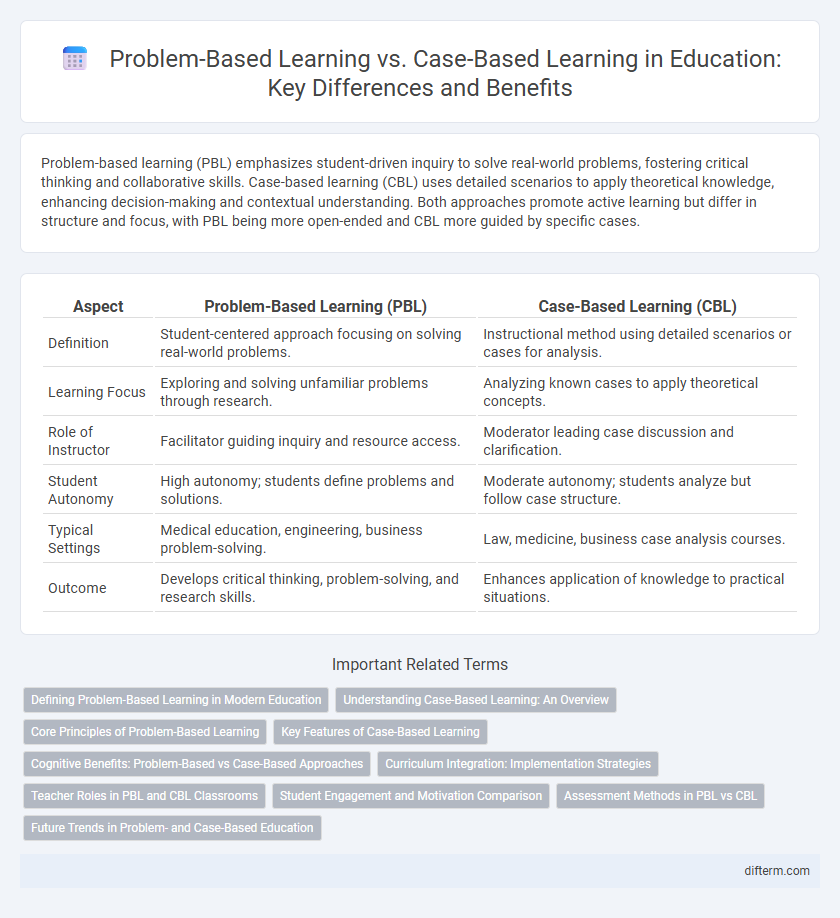Problem-based learning (PBL) emphasizes student-driven inquiry to solve real-world problems, fostering critical thinking and collaborative skills. Case-based learning (CBL) uses detailed scenarios to apply theoretical knowledge, enhancing decision-making and contextual understanding. Both approaches promote active learning but differ in structure and focus, with PBL being more open-ended and CBL more guided by specific cases.
Table of Comparison
| Aspect | Problem-Based Learning (PBL) | Case-Based Learning (CBL) |
|---|---|---|
| Definition | Student-centered approach focusing on solving real-world problems. | Instructional method using detailed scenarios or cases for analysis. |
| Learning Focus | Exploring and solving unfamiliar problems through research. | Analyzing known cases to apply theoretical concepts. |
| Role of Instructor | Facilitator guiding inquiry and resource access. | Moderator leading case discussion and clarification. |
| Student Autonomy | High autonomy; students define problems and solutions. | Moderate autonomy; students analyze but follow case structure. |
| Typical Settings | Medical education, engineering, business problem-solving. | Law, medicine, business case analysis courses. |
| Outcome | Develops critical thinking, problem-solving, and research skills. | Enhances application of knowledge to practical situations. |
Defining Problem-Based Learning in Modern Education
Problem-Based Learning (PBL) in modern education centers on student-driven inquiry where learners identify, analyze, and solve real-world problems, promoting critical thinking and collaborative skills. It contrasts with Case-Based Learning by emphasizing the formulation of problems without predefined solutions, fostering deeper engagement through active exploration. This approach aligns with constructivist educational theories, enhancing retention and application of knowledge in practical contexts.
Understanding Case-Based Learning: An Overview
Case-based learning centers on analyzing real-world scenarios to enhance critical thinking and decision-making skills in educational settings. This approach engages students by presenting complex, authentic cases that require application of theoretical knowledge to practical problems. By focusing on detailed case studies, learners develop deeper understanding and retention of subject matter compared to abstract problem-solving exercises.
Core Principles of Problem-Based Learning
Problem-based learning emphasizes student-centered inquiry by presenting real-world problems that drive knowledge acquisition and critical thinking. It requires learners to engage in collaborative problem solving, self-directed research, and reflection to construct understanding. Core principles include fostering active learning, promoting interdisciplinary connections, and developing skills for lifelong learning and problem analysis.
Key Features of Case-Based Learning
Case-based learning centers on the analysis of real-world scenarios to develop critical thinking and decision-making skills by applying theoretical knowledge. It emphasizes contextual understanding, allowing students to explore complex issues through detailed narratives and diverse perspectives. The approach fosters active engagement, collaboration, and reflective discussion, enabling learners to connect academic concepts with practical applications.
Cognitive Benefits: Problem-Based vs Case-Based Approaches
Problem-based learning (PBL) enhances critical thinking and problem-solving by engaging students in real-world challenges that require independent research and active knowledge construction. Case-based learning (CBL) concentrates on applying theoretical knowledge to specific scenarios, improving analytical reasoning and decision-making within a defined context. Both methods promote deep learning, but PBL emphasizes self-directed inquiry while CBL focuses on contextual understanding and application.
Curriculum Integration: Implementation Strategies
Problem-based learning (PBL) and case-based learning (CBL) require distinct curriculum integration strategies to maximize their effectiveness in fostering critical thinking and real-world application. PBL emphasizes student-driven inquiry aligned with interdisciplinary modules, often involving collaborative projects that integrate multiple subject areas simultaneously. CBL typically integrates within specific courses through curated real-life scenarios that connect theory with practice, facilitating incremental knowledge application and assessment throughout the curriculum.
Teacher Roles in PBL and CBL Classrooms
In problem-based learning (PBL) classrooms, teachers act as facilitators who guide students through open-ended problems, encouraging critical thinking and self-directed learning. In case-based learning (CBL), educators take on the role of content experts who provide context and structure, helping students analyze specific scenarios to apply theoretical knowledge. The teacher's involvement in PBL is more student-centered, promoting exploration, whereas in CBL, the role is more directive to ensure case comprehension and practical application.
Student Engagement and Motivation Comparison
Problem-based learning (PBL) fosters higher student engagement by requiring active problem-solving and collaboration, which enhances intrinsic motivation through real-world application. Case-based learning (CBL) increases motivation by presenting detailed scenarios that develop critical thinking and contextual understanding, appealing to students' curiosity and analytical skills. Studies indicate PBL often results in greater sustained motivation due to its dynamic, learner-centered approach, while CBL excels in deepening content knowledge and reflective learning.
Assessment Methods in PBL vs CBL
Assessment methods in Problem-Based Learning (PBL) typically emphasize formative evaluation through reflective journals, peer assessment, and group presentations, promoting critical thinking and self-directed learning. Case-Based Learning (CBL) assessments often focus on applying theoretical knowledge to specific scenarios via written reports, quizzes, and structured discussions to evaluate analytical skills and factual understanding. Both approaches utilize authentic assessment tasks but differ in their alignment with learning objectives: PBL centers on problem-solving processes, while CBL prioritizes case analysis and decision-making accuracy.
Future Trends in Problem- and Case-Based Education
Emerging trends in problem-based learning (PBL) and case-based learning (CBL) emphasize integrating artificial intelligence and adaptive learning technologies to personalize student experiences and enhance critical thinking skills. The rise of hybrid and virtual reality environments enables immersive case simulations and collaborative problem-solving, preparing learners for real-world complexities. Data analytics are increasingly leveraged to track student progress, optimize curriculum design, and identify knowledge gaps in both PBL and CBL frameworks.
Problem-based learning vs case-based learning Infographic

 difterm.com
difterm.com